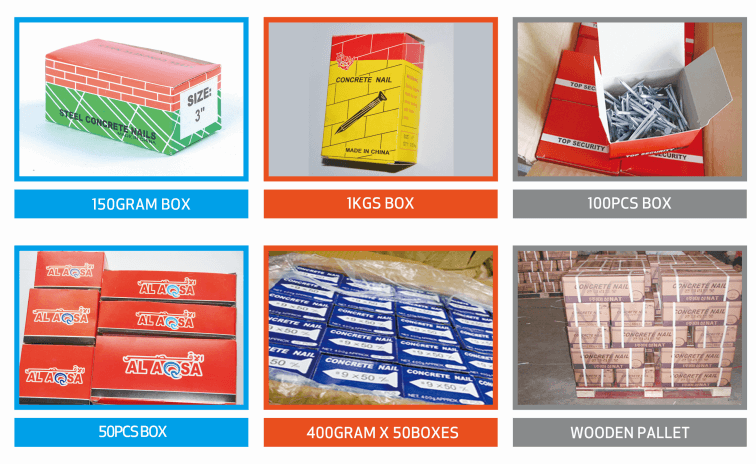Concrete Steel Nails / Steel Concrete Nails / Masonry Nails
concrete nails
steel nails
concrete steel nails
steel concrete nails
| Materials | 45# or 60# Carbon Wire Rod |
| Finish | Electro galvanized, Black finish |
| Head | Countersunk Plain head, oval head, or according to request |
| Shank | Plain shank, grooved shank, spiral shank, angular spiral shank |
| Point | Diamond Point |
| Packing | by box ,carton, plastic bags,etc . |

|
Concrete Steel Nails/ Masonry Nails
Shank: Grooved Shank, Twisted Shank, Plain Shank, Spiral Shank,Angular Spiral Shank |
|||
| SIZE | D1(mm) | D2(mm) | L (mm) | |
| 8BWG | 4.2mm | 20 | 2″,2.5″,3″,3.5″,4″ | |
| 9BWG | 3.76mm | 20 | 2″,2.5″,3″,3.5″,4″ | |
| 10BWG | 3.4mm | 20 | 2″,2.5″,3″ | |
| 11BWG | 3.15mm | 18 | 1.5″,2″,2.5″ | |
| 12BWG | 2.8mm | 16 | 1.5″,2″ | |
| 13BWG | 2.4mm | 14 | 1.5″,2″ | |

Concrete Nails Application: suitable for the connection of hardwood and light wood keel in the decoration industry. Suitable for hardwood, brick walls, and cement mortar components. Widely used in civil and military construction of water and electricity installation and decoration.
It has strong hardness and good toughness. The hardness of medium carbon steel is above HRC50; Shear strength t ≥ 980 MPa; Toughness curvature ≥ 75 degree
How to Drive Nails into Concrete by Hand
Attaching wood to concrete is one of those projects that occasionally comes up during remodeling projects. For example, if you are building partition walls in the basement or in a home with a slab-on-grade foundation, you will need to attach wood sole plates to serve as the base for the wall studs. Professional carpenters often use a powder-actuated nailer for this—a tool that fires special nails through the wood and into the concrete, using 22-caliber gun-powder cartridges. If you expect to be doing a lot of concrete nailing, you may want to consider investing in a powder-actuated nailer.
But if you have only a few nails to drive, driving them with a hammer is much more cost-effective. There are special hardened nails to use for this application, which are quite different than the nails used with a powder-actuated nailer. Concrete nails are made of hardened steel and have fluted shafts that help them sink into the concrete. You can also use masonry nails, which have a square cross-section and are tapered from the head to the tip. Masonry nails are cheaper than concrete nails and are less likely to break or bend.
When hammering concrete nails or masonry nails, it’s best to use a framing hammer, which is heavier and more substantial than a standard claw hammer. With its added weight and milled face (checkerboard ridged head), a framing hammer makes the job easier. Even with this heavier hammer, you will need to drill pilot holes for the nails. This is best done with a hammer drill and a masonry bit that is the same diameter or slightly smaller than the nails you’re using.
Note: When nailing lumber to concrete, make sure to use pressure-treated wood. Standard lumber can rot due to moisture that wicks through the concrete over time.